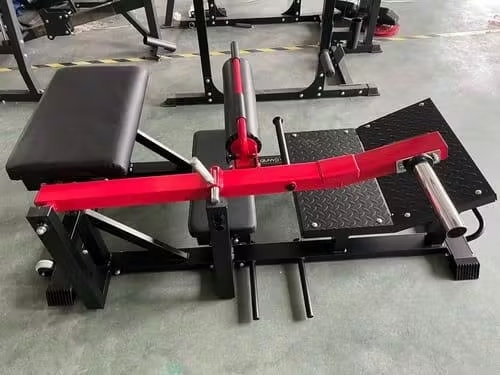
The hip thrust machine has rapidly become a cornerstone in modern fitness routines, especially for athletes and gym-goers looking to strengthen and shape their glutes. In this comprehensive guide, we’ll discuss everything you need to know about the gmwd hip thrust machine: what it is, how it benefits your lower body, and why it’s gaining popularity over traditional exercises like the barbell hip thrust or glute bridge.
What Is a Hip Thrust Machine?
A hip thrust machine is a specialized piece of fitness equipment designed to target the gluteus maximus, along with secondary muscles in the posterior chain such as the hamstrings and lower back. Unlike free-weight variations of the hip thrust exercise (where you might balance a barbell across your hips or use dumbbells), a dedicated hip thrust machine provides built-in padding, back support, and a guided track to maintain proper form.
Key attributes of a hip thrust machine include:
-
Adjustable padded seat or backrest: Offers stability and reduces lower back strain.
-
Pivot or hinge mechanism: Ensures fluid motion through the hip hinge movement.
-
Lever or plate-loading system: Allows you to add resistance easily while staying comfortable and secure.
The Benefits of Using a Hip Thrust Machine
-
Glute-Focused Development
The primary advantage of a hip thrust machine is that it isolates and emphasizes your glute muscles. By controlling the range of motion and keeping your back supported, you reduce the risk of over-engaging other muscle groups. -
Improved Posture and Pelvic Stability
Strong glutes contribute to better posture, helping stabilize your pelvis and spine. When you strengthen the gluteus maximus and supporting muscles, you improve overall core stability—beneficial for both daily activities and sports performance. -
Enhanced Sports Performance
Explosive movements like sprinting, jumping, and cutting all rely on powerful hip extension. By consistently training on a hip thrust machine, you develop the power and strength necessary for these athletic movements. -
Reduced Risk of Lower Back and Knee Injuries
Weak glutes can lead to compensations in the lower back or knees. Strengthening the glutes helps distribute load more effectively during activities such as squats, deadlifts, and even everyday movements like climbing stairs or picking objects off the floor. -
Comfort and Ease of Setup
Traditional barbell hip thrusts can be cumbersome—finding the right padding, balancing the bar, and ensuring safe placement. The hip thrust machine eliminates much of the hassle by providing a built-in support system.
How to Use the Hip Thrust Machine Properly
Proper form is essential for maximizing results and minimizing the risk of injury. Follow these steps to ensure you’re using the hip thrust machine effectively:
-
Position Yourself Correctly
-
Sit on the machine so that the padded support aligns with your hips.
-
Rest your upper back on the back pad (if available).
-
Bend your knees, placing your feet flat on the footrest or platform. Your shins should be vertical or slightly angled, depending on the machine’s design.
-
-
Engage Your Core
-
Tighten your abdominal muscles to keep your back in a neutral position.
-
Avoid overarching or rounding your spine.
-
-
Add Resistance
-
Load the machine with the appropriate amount of weight or adjust the lever.
-
Start light, especially if you’re new to hip thrust movements, and progressively increase resistance over time.
-
-
Execute the Thrust
-
Drive through your heels, pushing your hips upward.
-
Squeeze your glutes at the top of the movement.
-
Pause for a brief moment while maintaining tension.
-
-
Control the Descent
-
Lower your hips slowly to the starting position.
-
Maintain tension in your glutes and keep your core engaged.
-
-
Breathing Technique
-
Inhale at the bottom of the movement.
-
Exhale as you thrust your hips upward and contract your glutes.
-
Common Mistakes to Avoid
-
Overextending the Lower Back
Hyperextending your spine at the top of the movement can lead to discomfort or injury. Focus on lifting your hips until your torso aligns with your thighs. -
Using Momentum Instead of Muscle Engagement
Relying on momentum decreases muscle activation. Keep the movement controlled, and concentrate on glute contraction. -
Placing Feet Too Far or Too Close
Your feet should be positioned such that your shins are vertical or close to it at the top of the thrust. Feet too far away shifts the focus to your hamstrings; too close can reduce hip mobility. -
Neglecting Progressive Overload
Consistently challenge your muscles by increasing weight or adjusting resistance. Sticking to the same load will lead to plateaus in strength gains and muscle development.
Complementary Exercises for Well-Rounded Glute Training
While the hip thrust machine excels at targeting the glutes, a comprehensive lower-body routine can help you develop overall strength, power, and muscular balance. Some complementary exercises include:
-
Squats
-
Back squats, front squats, or goblet squats all engage your glutes, hamstrings, and quads.
-
Focus on a controlled descent and drive through the heels on the ascent.
-
-
Deadlifts
-
Variations such as conventional, sumo, or Romanian deadlifts train the entire posterior chain.
-
Keep your back neutral and engage your core throughout the lift.
-
-
Lunges and Split Squats
-
Bulgarian split squats, walking lunges, and reverse lunges build unilateral strength and correct imbalances.
-
Keep your torso upright and your front knee tracking over your toes.
-
-
Glute Bridges (Bodyweight or Weighted)
-
Similar to the hip thrust but performed on the ground.
-
Great for beginners to master hip extension before progressing to heavier variations.
-
-
Step-Ups
-
Targets glutes and quads while improving balance.
-
Aim for controlled upward and downward movements.
-
Training Tips and Programming
-
Frequency and Volume
-
For beginners, 2–3 hip thrust sessions per week with moderate loads can promote consistent gains.
-
Intermediate to advanced lifters can adjust volume (3–5 sets of 8–12 reps) depending on training goals.
-
-
Progressive Overload
-
Increase resistance gradually to stimulate muscle adaptation.
-
Track your progress and continually challenge yourself to avoid plateaus.
-
-
Mind-Muscle Connection
-
Visualize and feel your glutes contracting during each rep.
-
This heightened awareness enhances motor unit recruitment and leads to better results.
-
-
Add Variation
-
Experiment with tempo variations (e.g., pausing at the top or emphasizing a slower eccentric phase).
-
Try single-leg hip thrusts if your machine’s design allows for unilateral work.
-
Who Should Use a Hip Thrust Machine?
-
Beginners
-
If you find barbell hip thrusts intimidating or uncomfortable, a dedicated machine offers a beginner-friendly option.
-
Provides safer mechanics, allowing you to build confidence with the movement.
-
-
Intermediate to Advanced Lifters
-
Experienced athletes can still benefit from the stability of a hip thrust machine, as it allows for heavier loads while minimizing barbell setup issues and form breakdown.
-
-
Rehabilitation and Physical Therapy
-
Individuals recovering from back or knee injuries can use a hip thrust machine under professional guidance.
-
The controlled environment can help rebuild strength without putting excessive strain on vulnerable areas.
-
Conclusion
A hip thrust machine can be a game-changer for anyone looking to build strong, sculpted glutes while minimizing the complexities associated with free-weight movements. It offers targeted activation, supports proper form, and fits easily into diverse workout routines—benefits that make it a worthwhile investment in any gym setting.
By integrating a hip thrust machine into your workout program and complementing it with compound exercises like squats, deadlifts, and lunges, you’ll develop a powerful, balanced lower body. Always remember to focus on technique, listen to your body, and implement progressive overload to see continual growth and improvement. Your path to stronger, healthier glutes begins with the right tools—and the hip thrust machine could be the perfect addition to your fitness arsenal.





